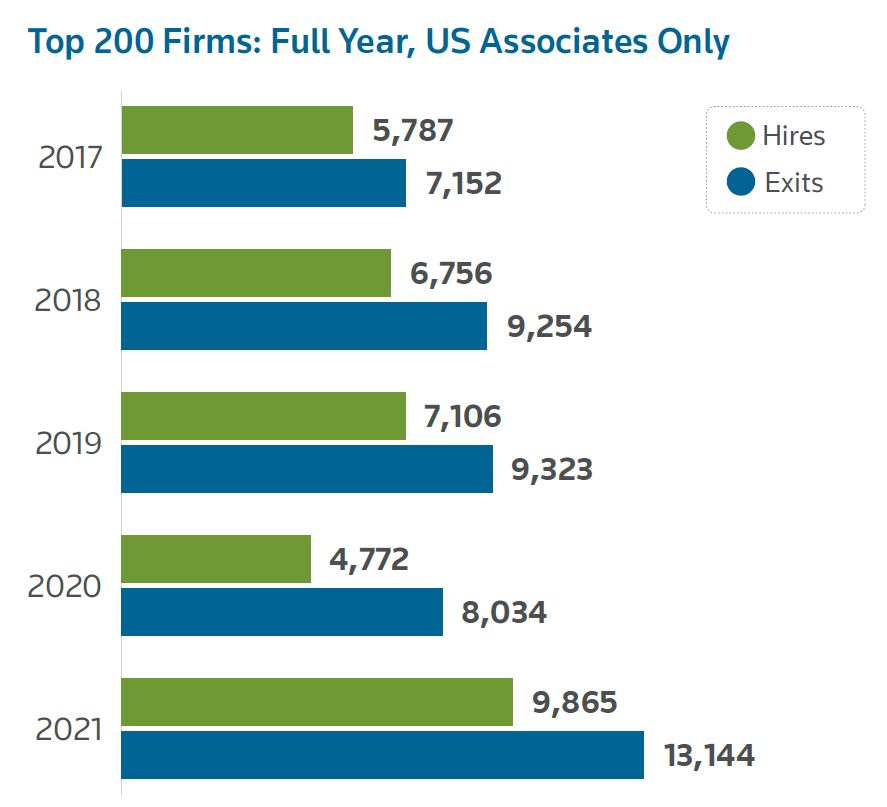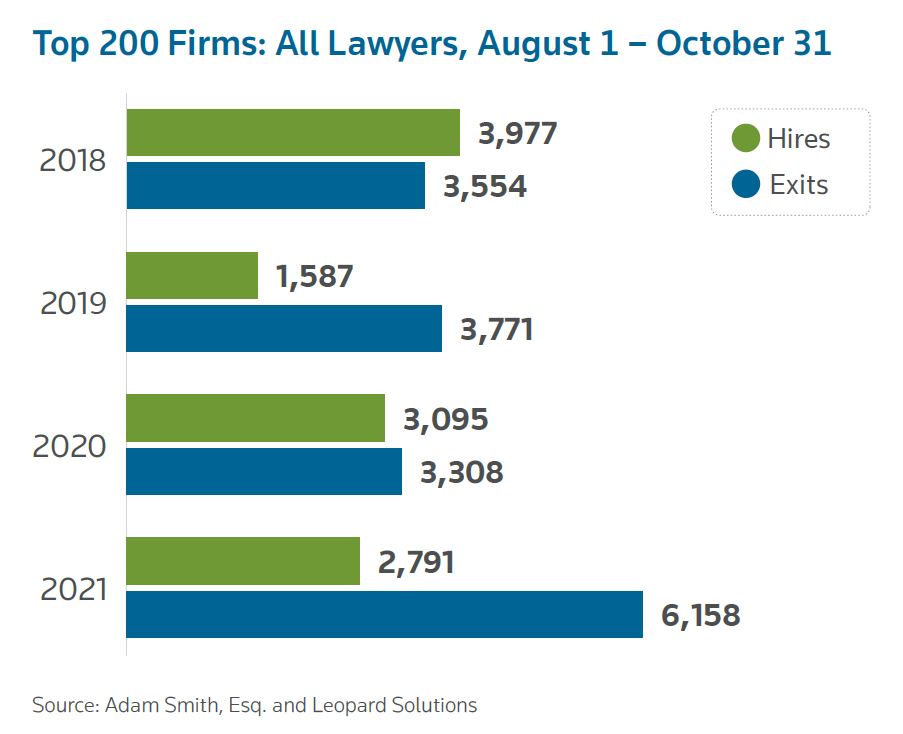Growing associate attrition and climbing compensation seem to be on everyone's mind in the legal industry, but what does the data say is really behind these twin trends?
The story of the year in the legal industry for 2021 seems to hold that associate attrition rates rose (and are continuing to rise) to all-time high levels — caused by punishing workloads — and law firms’ countervailing efforts to combat it have taken the form of whopping compensation increases.
Makes for a great story, but we noticed an uncomfortable disconnect: While the spectacular attrition rates and compensation increases are real, the higher workload is nowhere to be seen in the available data. Consider that across all law firms, we’ve seen a decrease in average billable hours per month from 134 about 10 years ago to 124 lately, a drop of 7.5%, according to the Thomson Reuters Institute’s “2022 Report on the State of the Legal Market.” We may be working hard, but you didn’t hear this story when we were working even harder.
Further, average turnover masks a wide span of what actual firms are experiencing: A gap of 13 percentage points (about 40%) separates those law firms with the highest and lowest turnover. But … (and here’s the punch line), if you compare those firms with the highest and lowest compensation growth, their associate attrition rates were indistinguishable. And odder still, the firms with higher billable hours had lower attrition.
I told you the data was weird.
However, as a beloved finance professor once told me, “Numbers don’t have opinions.” So, if the data cannot be weird, something must be wrong with our interpretation of the current situation.
First, we can drill down into the data a bit more than we have. A truism of statistics is that averages can mislead, and it turns out that counsel applies here. Recent strong legal demand growth has been driven chiefly by burgeoning work in the corporate practice area, according to the most recent report from Thomson Reuters Peer Monitor, with recent 7.7% annual growth in 2021 compared to the previous year. That compounded growth level would produce a doubling in less than a decade.
Underpinning these numbers are the massive pools of liquidity pouring into private equity, hedge funds, project finance, and strategic and financial M&A, and the buy-side asset holders are demanding that cash be put to work. That means, however, the burden of getting deals done falls primarily on the shoulders of the partners and particularly the mid-level associates in the dozen or so truly elite law firms with global reach. No wonder associate attrition is at all-time highs.
And it really is — and the sense of what’s going on finds powerful confirmation in the numbers. First, the last five years of arrivals and departures (hires and exits) limited to US-based associates:

And second, the hires and exits for “all lawyers” during a critical three-month period late in the year:

We’re as fond of data as the next person, but enough already. This story began with a decades-high spike in associate workload coupled with a decades-high spike in associate compensation, but if the second was supposed to ameliorate the first, it didn’t seem to be working. Firms with the heaviest workloads and those stingiest on comp were retaining more associates, not fewer! What gives?
Let’s start with what’s been missing from this conversation until now: The human element.
Consider how the long dark Tunnel of the Pandemic that humanity has been passing through for the past two-plus years has overturned everyone’s lived experience. Not only did everything change overnight, the pandemic packed a witches’ brew of all that psychology teaches is most disorienting: It was unforeseeable, uncontrollable, mysterious, lethal, polarizing, and to top it all off, isolating. Humans crave shared experience, which was not to be had. Yet in our world of work, its burdens fell unevenly. Simply put, they fell heaviest on junior and mid-level associates; and some of these burdens included:
Stress
We know a lack of control raises stress, while autonomy eases it. Partners and senior associates had at least some or a lot of autonomy while juniors had less or none. It might be an exaggeration to say that during the pandemic, stress became negatively correlated with seniority, but it’s a first approximation.
Isolation
Partners and senior associates in general have broader and deeper personal networks, with luck more established and fuller personal lives, and almost certainly larger and more spacious homes. The stereotype is of the partner with a large home with ample breathing room, space, companionship and comfort; while the young associate lives in a studio apartment in a cookie-cutter white brick building. And when the pandemic hit, each law firm employee became isolated in their own respective home. Worse yet, social life and human interaction centered on the office, and it was yanked away with a still uncertain return date. And Starbucks is a poor substitute.
No boundaries
During the pandemic, work and life boundaries melted away. While this may sound liberating, the exhausting reality is that without boundaries you begin to feel that you’re always working and always cooking, cleaning, caring for children and dogs, getting things out, and putting things away, in a ceaseless loop.
These boundaries are crucial. Without them we’re frazzled, half-attentive, distracted; and it feels as if we’re struggling against constant friction and resistance just to get from waking to sleeping.
Finally, it’s important to remember it’s not about the money. People at this level aren’t motivated by money — certainly not those you want to have working at your firm. Pay is consistently listed somewhere in the bottom half of the Top 10 reasons people give when asked what they value about their work. Well ahead come autonomy, satisfaction at a job well done or a client well served, the camaraderie of colleagues, intellectual challenge and personal growth, seeing the firm thrive, gaining the respect of peers, solving problems, embodying high standards and achieving mastery.
And if law firm leaders are to address the attrition of their youngest professionals and show management cares about the future of the firm — which strongly depends on the caliber of talent it can offer — then leaders need to define, articulate and communicate compelling answers to the following questions:
-
-
-
What “secret sauce” do we provide to clients that other firms just can’t?
-
What are we building here?
-
What does this firm stand for?
-
How can we leave this place better than we found it?
-
-
Insipid, boilerplate or unconvincing answers will repel everyone — and no amount of money will make them stay. Top law firm leaders will give their employees something of far greater value than their salary. Inspiring answers to those questions will motivate people to put up with a lot and perform better than leaders might expect.
Studs Terkel, the magisterial oral historian of work, condensed it brilliantly: “Work is about a search for daily meaning as well as daily bread, for recognition as well as cash, for astonishment rather than torpor; in short, for a sort of life rather than a Monday through Friday sort of dying.”
People don’t just yearn for that, they need it.






